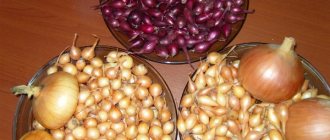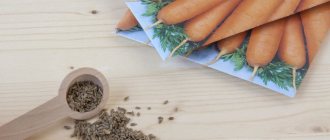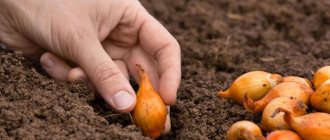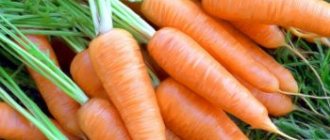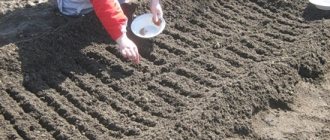Landing dates
The yield of vegetable crops depends on the timing of autumn sowing. It is important that the seeds do not have time to germinate before the onset of winter. If they germinate in the fall, then after the arrival of frost the seedlings may freeze, so no harvest will be obtained.
It is worth planting winter carrots only after the onset of stable cold weather and an average daily temperature within 0...+3°C. If warmer temperatures and rains are expected in the future, sowing the seeds will have to be delayed, otherwise they may germinate.
The optimal time for planting is at the end of October - beginning of November. In the conditions of the southern regions, carrots can sometimes be sown in late autumn, and in the northern regions - in the last days of September. The main thing is to sow at least a week before permanent frosts.
Carrots should not be sown too early or too late. In addition, it is undesirable to sow on the days of full moons and new moons.
The secret of tasty and healthy carrots is in your hands
So, in order to keep a supply of tasty and healthy carrots in your basement in winter, you need to follow simple rules for preparing the soil for planting in the fall and spring, and also properly care for the future gorgeous harvest:
- prepare the soil twice a year - carefully dig up the soil in the fall, adding the necessary fertilizers depending on the composition of the soil. In spring, loosen and fertilize before planting.
- prepare the seeds by soaking them in water a day before planting.
- plant the seeds correctly, avoiding excess moisture in the beds or cold.
- thin out the seedlings and maintain sufficient distance between growing root crops.
- Timely water or dry the area where the carrots grow. Remember, she loves warmth and sun!
We hope these tips will help you grow an excellent harvest of tasty and, most importantly, very healthy carrots that will supply you with vitamins and minerals all winter!
What varieties should I plant before winter?
For sowing before winter, it is better to choose cold-resistant early and medium-growing varieties of carrots, which include:
- Moscow winter A 515. A variety with a ripening period of 70-100 days and high yield (5-7 kg per 1 sq. m). The orange fruits have an elongated conical shape, weigh 100-170 g and reach 15-18 cm in length. The pulp is juicy and has a pleasant smell.
- Vitamin 6 . A variety with a growing season of 80-110 days, when sown in autumn, it is possible to obtain mature cylindrical root crops already in July, weighing up to 80-130 g and up to 17 cm long. They are well stored, but are prone to cracking.
- Nantes 4 . It takes about 80-100 days from full germination to harvest. Root vegetables weigh up to 100 g, have a cylindrical shape, a length of 14-16 cm and tender but juicy pulp. Productivity – 6.5 kg per 1 sq. m. The vegetable is resistant to rot and mold, but is prone to blooming. For sowing in the autumn season, you can also choose seeds of the Nantes improved variety. This crop bears fruit with root crops weighing up to 90-160 cm and has a yield of 5-7 kg per 1 sq. m.
- Shantane-2461 . A variety with a growing season of 80-120 days, which produces root crops of a truncated conical shape and weighing 100-250 g. Shantane does not tolerate excess organic matter in the soil, but is not afraid of cold weather and is resistant to flowering.
- Losinoostrovskaya-13 . The growing season is 80-120 days. Root vegetables weigh 80-120 g, are cylindrical in shape, and are not afraid of rot and mold. The variety is demanding when it comes to watering.
- Incomparable . Carrots with a ripening period of 105-130 days. Root vegetables weigh 100-200 g and have a truncated conical shape. The variety is resistant to flowering, dry soil and cold snaps.
- Nantik Resistafly F1 . A hybrid with a ripening period of 85-90 days with an erect rosette of leaves. Smooth, cylindrical root vegetables weigh 95-120 cm and reach 18 cm in length. They can be stored for up to 5 months. Plant productivity is 7-9 kg per 1 sq. m.
- Samson . A variety with a growing season of 110-120 days, which produces root crops weighing 130-300 g. They are not afraid of flowering and cold, and are also well stored.
- Nandrin F1 . Carrots with a growing season of 95 to 105 days. The smooth, cylindrical fruits weigh 150-250 g and reach 20 cm in length. The peculiarity of this carrot is that it has practically no core.
- Touchon . A representative of the Amsterdam variety with a growing season of 80-100 days. Root vegetables weigh 100-150 g and reach 15-20 cm in length. They have a sweet taste and delicate structure. Tushon grows well on light sandy loam soils.
- Nectar F1 . The period from full germination to technical ripeness of the hybrid is 120-125 days. The dark orange root vegetables weigh 100-150 g, have a cylindrical shape with a blunt tip and a sweet taste. The hybrid is not subject to cracking and discoloration.
- Flakke . A variety with a growing season of 110-150 days, which produces root crops weighing 180-220 and having a truncated conical shape. They do not crack and do not accumulate nitrates.
- Children's sweet . Based on the name, it is obvious that the variety is excellent for preparing food and drinks for children. The growing season is 110-112 days. Red-orange root vegetables weigh 90-130 g, reach 18-22 cm in length and have the shape of a cylinder with a rounded tip.
It is best to buy granulated (panned) seeds that have already undergone the necessary pre-sowing treatment. In addition, they are much easier to sow than very small seeds.
Which varieties of carrots are most suitable for sowing before winter are described in the following video:
Advice from experienced summer residents
Listen to the advice of more experienced gardening comrades:
- Do not apply manure when planting crops, otherwise the root crops will become tasteless, rough and have an uneven color.
- Carrots can be planted in the same place every three years.
- Carrots are planted in soil with a neutral pH. If it is acidic, liming is carried out.
- When the seedlings reach a height of 5 cm, they are thinned out. The distance between plants should be at least 5 cm, then they will have enough light and nutrients.
- In mid-summer they thin out a second time. Small carrots can be eaten, and the remaining root vegetables are suitable for long-term storage.
- In dry weather, carrots are watered every other day, in normal weather - 1-2 times a week.
- Root crops are harvested in dry weather. They are laid out on the garden bed, dried, then sorted and stored.
Site selection
When planting carrots before winter, special attention must be paid to choosing the location of the bed. It should be located on a flat area, protected from winds and well warmed by sunlight.
Seeds should not be sown on a slope, as they may be washed away during the spring snow melt. The soil itself should be loose, light and fertile. The best option is loamy or sandy loam soil with low or neutral acidity, since it is loose and nutritious, and does not become very compacted during the winter.
If the site meets these requirements, you need to identify what crops have grown on it over the past 3 years. According to the rules of crop rotation, the best predecessors of carrots are:
- potato;
- onion;
- cabbage;
- tomatoes;
- cucumbers;
- squash;
- zucchini;
- melons (melon, pumpkin, watermelon).
The best harvest of root crops can be obtained if the listed crops grew on the site, under which humus or compost was added to the soil.
As for the worst predecessors of carrots, these are:
- beans;
- parsley;
- dill;
- fennel;
- celery;
- carrot.
After such crops, root crops can only be grown after 3-4 years to avoid infection with common diseases and pest attacks.
After fertilizing the soil with fresh manure or humus, you can sow carrots only after 2 years. If you do this right away, the tops will turn out tall and juicy, and the root crops will be deformed and branched.
Soil types
Carrots, although an unpretentious plant, love loose loamy and sandy soil. Such soil gives carrots the sweet and juicy taste that we all appreciate so much. The soil should not be acidic, ideal acidity (pH) is 5.6-7.
A better composition is achieved by adding the missing elements. First, you need to determine the type of soil; for this, let’s remember a simple rule: take a handful of soil and soak it. Next we try to form a ball from the resulting mush. If the mass crumbles in your hands, then such soil
How to Make Soil Suitable for Growing Carrots
Once the soil type is determined, it becomes clear what needs to be done next. If your plot consists of fertile black soil, you don’t need to do anything other than regular fertilizers. Peat soil will require sand, clay soil will require sand with peat.
Soil preparation
The area for sowing carrots must be prepared in advance, before the cold weather arrives, when the soil has not yet frozen. So, 1-1.5 months before planting, you need to perform the following steps:
- Clean the area after the previous crop, removing all weeds and plant debris.
- Conduct a deep digging of the bed with a spade blade (30-40 cm). In this case, it is worth fertilizing the soil, but avoiding organic matter in the form of manure. It is best to add 2-4 kg of humus, 20-25 g of superphosphate and 10-15 g of potassium salt per 1 square meter to the soil. m. Mineral fertilizers can be replaced with ash, since it contains phosphorus, potassium, magnesium, calcium and other elements. Apply it at the rate of 1 glass per 1. sq. m. m. Select other fertilizers depending on the type of soil:
- In acidic soil, be sure to add either 1 glass of wood ash, or 150 g of dolomite flour, or 300-400 g of chalk per 1 square meter. m, since they neutralize the acidic environment;
- heavy, clayey soils should be diluted with sand or half-rotten sawdust, as they will make the soil more airy and loose, but fresh sawdust and other undecomposed components of organic nature must be discarded, otherwise they will attract carrot flies that are dangerous to root crops;
- Poor soils should be additionally fertilized with nitrogen fertilizers at the rate of 1 tbsp. l. per 1 sq. m, but no more, since exceeding the specified dosages will not enhance the plant’s productivity, but will lead to cracking and deformation of the root crops.
- After digging, loosen the soil deeply and make grooves in it to a depth of 4-5 cm and every 15-20 cm. When the time comes to sow the seeds, the grooves will compact and settle, so the depth will not exceed 2-3 cm.
- Cover the prepared area with film or other material that does not allow moisture to pass through, so that the bed is not washed away by rain and the ground is not blown away by the wind. The sides of the shelter must be secured with bricks, boards, stones or any other heavy material that can be found at hand.
You can sow any green manure on the site and, when it grows to 15-20 cm, embed it in the soil, since carrots love a high humus content.
Carrot seeds can simply be sown on the surface of the soil without making any furrows. The area will simply need to be sprinkled with pre-prepared loose soil and covered with spunbond, which can be removed in the spring when the snow melts.
However, even when sowing seeds in furrows, it is necessary to prepare a dry mixture in advance to seal them. Sowing work is carried out at a time when the soil is already cold, and in some places it even freezes into clods, so it will not be possible to evenly cover the seeds with it.
While the weather is warm, you need to prepare dry soil, sifted through a coarse sieve, as well as compost, humus or a mixture of them with peat at the rate of 4-5 buckets per 1 square meter. m (it is advisable to sort the composition with your hands so that there are no lumps, and dry in the sun). Pour the workpieces into boxes or bags, which should be kept in a dry and warm place, for example, in a frost-free barn.
If the dry mixture for sowing the seeds is not prepared, you will have to purchase ready-made peat-based soil at the garden store. A crust does not form on it, so it will not be difficult for sprouts to break through.
You can learn about the method of preparing a bed for autumn sowing of carrots from the video below:
Sequence of work on preparing beds in the fall
Weeding autumn beds
The harvest is harvested and the gardener is faced with the question: how to prepare the bed in the fall for planting next spring. We are developing a strategic plan for upcoming work:
- First you need to remove plant debris from the beds: tops, stems, leaves. Some gardeners prefer to throw out or burn all excess organic matter. But it is better to put this green mass in a compost pit for rotting. Next year you get free fertilizer for cultivated plants. You can save excess organic matter as mulch and cover the beds with it in a low layer.
- Clean the garden from weeds more thoroughly. In this case, it is advisable to remove not only the above-ground part of the plants, but also the roots. If the garden is heavily overgrown with unnecessary plants, then it is treated with some kind of herbicide. Many systemic drugs are sold that help control various weeds. There are also products designed for specific plants.
- Now it's time to tackle the ground. Experienced gardeners advise digging up the beds with parallel application of fertilizers. This will replace the nutrients that were spent on previous plants. During the long winter, the fertilizers will just “reach”, and in the spring the young shoots will be able to get enough of them. In the fall, soil with a low acid-base balance can be limed or chalked.
- Before the winter cold, you can cover the ground with a layer of mulch - organic residues: leaves, tops, grass. Such soil will withstand frosts more easily and will better preserve plants planted before winter. Next, the layer of mulch overheats and becomes a good fertilizer for the beds.
And, of course, it is worth considering a plan for future spring plantings, based on correct crop rotation. With a rational system of alternating garden crops, the soil is less depleted, the plants are better protected from diseases and pests, and the vegetable yield increases.
Preparing seeds for sowing
Not all carrot varieties are suitable for autumn planting. Therefore, when purchasing seeds, you need to ensure that the packaging indicates that this crop is suitable for sowing before winter. It is advisable to purchase seeds immediately from a specialized store, since their high quality significantly increases the chance of getting good seedlings.
There is no need to treat seeds with growth stimulants before planting, since when planting in autumn, the goal is not to achieve rapid germination. On the contrary, this should not be allowed, since with their rapid germination there is a high probability of losing the entire crop.
As a last resort, the seed can be dipped in a weak solution of potassium permanganate to disinfect it from possible diseases. After soaking, they must be thoroughly dried, since seeds for winter sowing must be dry.
When sowing carrots before winter, the seed rate should be increased by 20-25% in order to insure in case of snowless weather and thaw.
Soil types
Carrots, although an unpretentious plant, love loose loamy and sandy soil. Such soil gives carrots the sweet and juicy taste that we all appreciate so much. The soil should not be acidic, ideal acidity (pH) is 5.6-7.
A better composition is achieved by adding the missing elements. First, you need to determine the type of soil; for this, let’s remember a simple rule: take a handful of soil and soak it. Next we try to form a ball from the resulting mush. If the mass crumbles in your hands, then such soil
How to Make Soil Suitable for Growing Carrots
Once the soil type is determined, it becomes clear what needs to be done next. If your plot consists of fertile black soil, you don’t need to do anything other than regular fertilizers. Peat soil will require sand, clay soil will require sand with peat.
Sowing seeds in the ground
With the arrival of persistent cold weather, a drop in temperature to +5°C and freezing of the soil to a depth of 5-8 cm, you can begin sowing seeds on the frozen ground. As a rule, favorable conditions occur in late October - early November. The sowing instructions are as follows:
- If the prepared area is covered with snow, carefully clear it with a broom.
- Pour dry seeds at a distance of 3-4 cm from each other into previously prepared grooves to a depth of 1 cm (for dense soil) or 3 cm (for light soils in dry areas). Seeds can simply be sown directly on the surface of the ground. To ensure accurate planting, it is better to use a special seeder for carrots, on which you can set the optimal sowing step. The seed consumption rate for winter planting is 0.8-1 g per 1 square meter. m. When planting in spring, this figure is 0.6-0.8 g per 1 sq. m. m.
You can also sow radish or lettuce seeds in the garden bed so that in the spring they will mark rows of carrots for more comfortable weeding and loosening of rows.
- Seed the seeds with pre-prepared dry soil, and then mulch the bed with organic matter with a layer of 3-4 cm. The mulch needs to be compacted so that it does not get blown away by the wind.
- At the first precipitation, rake the snow onto the bed and press it with spruce branches to cover the layer of mulch. In conditions of little snow in winter or areas with constant droughts, it is worth additional measures to retain snow in the garden bed. To do this, it needs to be covered with a layer of coarse mulch, for example, large branches, fallen leaves, spruce and pine spruce branches.
The crops do not need to be touched until the spring thaws, since in winter the seeds will simply “sleep” in the ground.
How to ensure comfort in the garden beds
Carrots grow slowly and, as already mentioned, are afraid of excess moisture. If the soil has the ability to accumulate water, then organize ridge beds - raise the soil by 25-35 centimeters. If the soil dries well, then simply make grooves with a distance of 20-25 centimeters from each other. Before planting, the ground is leveled and loosened a couple of days before planting, then watered. You can cover it with film so that the earth “steams”. The seeds are soaked before planting. Plant the prepared seeds in stripes at a distance of one and a half to two centimeters from each other. Then the top is covered with a mixture of organic fertilizers or peat with sand, depending on the prepared soil.
After this, the bed is covered again with film. This is necessary to save heat and moisture; if everything is done correctly, then with this method, seedlings appear already on the sixth day after planting. As soon as the first green shoots appear, the protective film is removed.
Carrot planting dates
In Russia, carrots traditionally begin to be planted at the end of April, when the likelihood of night frosts is minimal.
– from April 20 to April 25, early varieties of carrots;
– until May 5, mid-season varieties.
For the southern regions, other dates are mid-March and mid-June for the second landing.
Spring planting care
Caring for winter carrots involves timely implementation of a number of activities:
- When the snow begins to melt, remove the spruce branches from the garden bed. You can also rake some of the snow to melt it faster.
- After the snow has completely melted from the garden bed, remove all branches and grass from it. Next, install low arcs along the perimeter of the area, and stretch film or non-woven material over them. This is done in order to protect the seeds from night frosts and speed up their germination.
- When the first shoots appear, remove the covering material. In this case, the weather should already be consistently warm with an average daily temperature of +15°C and above.
- When dense and friendly shoots appear, it is necessary to thin out the plant, leaving a distance of 1.5-2 cm between them. After 2-3 weeks, remove the excess shoots again to increase the interval to 4-6 cm, otherwise the root crops will grow very small. However, when sowing seeds using a seeder, the need for thinning may disappear altogether.
- When the first greenery appears on the surface of the bed, you need to start weeding. Remove weeds only by hand, since when herbicides are applied, root vegetables cannot be eaten for the next 4 months.
- Treat the crop against carrot pests on the 15th day after emergence. To combat snails and slugs, you can use Thunder or another drug.
- During the period of intensive plant growth and when 3-4 true leaves appear, carrots need to be fed. To do this, it is enough to apply a complex fertilizer once, for example, nitrophoska or Fertika, marked “universal,” into the inter-row spacing.
- If a dried crust appears on the ground, the soil must be watered so that it becomes evenly moist. Under no circumstances should it be allowed to become over-watered, since even with slight stagnation of water, the plant can rot. After watering the soil, it is also worth loosening the row spacing.
Harvesting
When planting carrots before winter, the root crop can be harvested already in the first ten days of June. They can be collected even before they reach technical maturity. The fact is that even fruits whose diameter does not exceed the thickness of a finger can be eaten.
When harvesting, root vegetables should be dug up or carefully pulled out, separated from the tops and stored in a dark, cool and dry place. Carrots should not be left in the garden, because under the pressure of sunlight they will become lethargic and lose some of their nutrients.
Winter varieties of carrots are not suitable for long-term storage, so they should be eaten in the summer.
What carrots love. Landing technology
Carrots love light and warmth, so you need to plant the plant in an area with good access to sunlight throughout the day. Lack of light can lead to a decrease in the quantity and quality of the crop.
Another important factor is the rotation of cultures over time and territory. This means that carrots cannot be planted in the same place all the time. And also it cannot be planted in the area where these plants grew:
· curly parsley;
· fragrant (garden) dill;
· parsnip;
· celery.
It is best to plant carrots in an area where cabbage, tomatoes, cucumbers or onions grew.
The choice of sowing time is no less important. It affects the amount of harvest and the size of an individual root crop. The ripening time depends on the chosen variety, often this time varies greatly. When choosing a variety, you should first of all focus on the desired harvest time.
To obtain early carrots, 2 types of sowing are practiced: winter and spring. The use of the first option is limited by climate. If the climate is harsh, then this method is not suitable, since the cold will cause the seeds to deteriorate. A few more disadvantages of this method are that the carrots may bloom and go into arrows, it is impossible to determine the duration and temperature fluctuations of the upcoming winter, and it is also difficult to choose the timing of sowing. The second option is less troublesome and is what gardeners most often prefer. Spring sowing is carried out after the top layer of soil has warmed up.
A possible decrease in temperature will affect the storage time of root crops and may also accelerate the formation of shoots. To avoid this, gardeners use quickly ripening varieties that are not afraid of such games of nature. The downside of this variety is its unsuitability for long-term storage. Only long-ripening varieties are suitable for this, but they can only be sown at a stable temperature of +15> degrees Celsius.
Before planting, you need to select viable seeds. To do this, place the seeds in a small bowl and fill them with warm water, after which the seeds are allowed to brew for about half a day. All non-viable seeds will float. By the way, this procedure will also speed up the germination of seeds. It is not recommended to skip this step. After sifting out the “rejects,” the seeds are placed in a damp piece of cotton wool for seventy-two hours, at a temperature of twenty degrees Celsius. At the end of the period, the seeds will hatch.
Before planting, you should prepare the soil in advance, dig shallow grooves and water them well. The ditches should not be very small to protect the seeds from gusts of wind. Nor should they be deep, as this will reduce the chances of seed germination. Optimal dimensions: depth - thirty millimeters, minimum distance between ditches - one hundred and fifty millimeters, distance from seed to seed - twenty millimeters.
Features of growing winter carrots in different regions
Many gardeners complain that winter carrots go to waste in the spring. This is due to one of two reasons - sowing low-quality seeds or stress resulting from prolonged exposure of seeds to cold soil.
Despite the second reason, the seeds should still be sown in frozen soil, otherwise they may germinate until spring. Meanwhile, depending on the region of cultivation, there are a number of recommendations, if followed, you can increase the likelihood of obtaining a rich harvest.
Moscow region
In the middle zone, sowing seeds should be done at the end of October - beginning of November, when the soil temperature drops to +2-3ºC. The weather should be stable, but with light frosts, so that the sown seeds have time to swell before the real frosts arrive.
Among the cold-resistant carrot varieties for autumn sowing in the Moscow region, the following are most suitable:
- Losinoostrovskaya-13;
- Nantes-4;
- Incomparable;
- Moscow winter;
- Callisto.
Ural
In the Urals, the same agrotechnical measures are carried out as in the middle zone, but for sowing it is better to choose seeds of such varieties as:
- Nantes-4;
- Mo;
- Moscow winter;
- Vitamin-6;
- Altai shortened;
- Incomparable.
When growing carrots in the Urals, it is important to cover the bed well for the winter with a layer of mulch and spruce branches.
Siberia
In this region, the varieties most resistant to the harshest weather conditions are most suitable for sowing before winter. These include:
- Shantanay;
- Nastena has a sweet tooth;
- Altai shortened;
- Dayana;
- Queen of Autumn;
- Nantes-4;
- Vitamin-6;
- Losinoostrovskaya-13.
In Siberia, sowing work is best done between mid-October and mid-November.
What kind of soil is needed for a carrot bed?
Carrots do not like heavy soils: they become deformed and lose their sugar content. On light soils it develops freely, easily making its way deeper. Sandy areas with good ventilation and moisture permeability are considered the most successful for it.
The optimal soil for any carrot variety must meet the following requirements:
- be permeable to oxygen and moisture;
- do not contain weeds and debris: pebbles, root debris, solid waste;
- have the necessary nutrients;
- have an acidity level not higher than normal.
When choosing a place for carrots, look for well-lit areas. Zones excluded:
- with high drying speed;
- with a large slope;
- on which wheat grew as green manure (due to the remains of roots).
Land areas where such conditions do not exist are corrected when preparing the landing site:
- For clay soil and chernozem, sand is added: 1 kg per square meter. m of land.
- Humus, manure, and potato peelings are added to the sandy soil.
- Soil acidity is reduced with alkaline components (lime, chalk, gypsum, ash).
From an overabundance of fertilizers, the root crop loses its taste, rots, becomes overgrown with small roots, is poorly stored, and from a deficiency it grows slowly, gets sick and becomes prey for the carrot fly.
The lack of nutrients in the soil is compensated by fertilizers. It is more advisable to apply mineral supplements in the spring. In the fall, organic fertilizers are added to the digging. Depending on the condition of the land, the following are most often added to manure:
- mowed lawn grass;
- leaves;
- compost from waste;
- peat;
- sphagnum moss;
- bark, sawdust, coconut fiber, etc.
Advantages and disadvantages of planting carrots before winter
The advantages of sowing carrots before winter are as follows:
- The gardener manages to get an early harvest of root crops. If spring carrots need to be collected in July, then autumn carrots should be collected in June.
- When planting in autumn, with the arrival of spring, the seeds grow without delay, since during the cold period the essential oils that inhibit their germination disappear from them.
- During the germination period of seeds planted in the fall, there is a lot of natural moisture in the soil, thanks to which you can save time on watering the bed and get tastier carrots. It is known that natural moisture (snow, rain) contains more beneficial elements for plants than water from a tap or even a well.
- The gardener manages to unload the busy spring schedule, because there is much more time in the fall than in the spring.
As for the disadvantages of autumn sowing of carrots, they look like this:
- if the correct planting technology is not followed, the seeds will freeze, so you will not be able to get a rich harvest;
- seed consumption is much higher than in spring, since from the very beginning you need to count on the fact that part of the seed will die;
- there is a risk of spring thaws, during which the seeds will germinate, but with the return of frost the seedlings will freeze and die;
- Winter carrots can be stored for no more than 2-3 months, so the crop often has to be sown in the spring.
Compliance with all the rules for cultivating carrots in the fall will allow you to get an excellent harvest in mid-July. Seeds of varieties planted in spring will only ripen at this time. Collected root vegetables must be consumed as soon as possible, since they are not intended for long-term storage.
0
0
Copy link
Why and who needs autumn sowing of carrots?
As with other crops, winter sowing of carrots has its advantages and disadvantages. The main advantage is that you don’t have to waste valuable time in the spring, the other is that already in early June the crop reaches food maturity. Carrots grow large, juicy and smooth due to feeding on melt water and timely fertilizing. Early spring is characterized by a small number of potential pests, so the risk of crop damage is low. An additional plus is that after harvesting the carrots, vegetable growers have time to grow lettuce, radishes and other crops in the vacated area and harvest before the fall.
The disadvantage of sowing carrots in winter is their short shelf life - the root crops quickly deteriorate. If you use early-ripening varieties for planting, an unexpected thaw will provoke their growth, and subsequent frosts will destroy the sprouts.
Suitable dates
According to the lunar calendar, “male” fruits are collected and planted on the appropriate dates, and the same is done with “female” plant crops. Beets and carrots are female vegetables, which means that it is correct to work with them on female days of the week: Wednesday, Friday, Saturday. Regarding the last day, the opinions of gardeners and folk sorcerers do not agree:
- summer residents consider Saturday to be an ordinary day;
- sorcerers talk about the prohibition of any manipulations in the garden except pruning and uprooting, since this day is patronized by the heavy planet Saturn.
According to the moon, vegetable crops that will be stored all winter are harvested during the waning phase. During this period, the movement of juices inside the plants slows down; they are, as it were, preserved. If you dig root vegetables while the moon is waxing, the vegetables will quickly become limp. When harvesting vegetable crops, keep a reference point to the moon; the following are noted on the calendar:
- lunar phases;
- day;
- planets;
- Zodiac signs.
The table of favorable harvest days helps you avoid making mistakes when planning work.
| Allowed dates for early and mid-ripening varieties | Moon position | Allowed dates for late-ripening varieties | Moon position |
| 03.09 | The moon is waning, 15-16 lunar days, in the sign of Pisces | 04.10 | The moon is waning in the sign of Taurus, cleaning is allowed from 12-00 to 15-00 Moscow time |
| 04.09 | The moon is waning, 16-17 lunar days, in the sign of Aries, you can collect vegetable root crops for seed material | 06-09.10 | The moon is waning, 19-23 lunar days, in the signs of Taurus, Gemini and Cancer |
| 08-10.09 | Waning, 20-23 lunar days, in the signs of Taurus and Gemini, the most suitable dates | 13-15.10 | Waning, 25-28 lunar days, in the signs of Virgo and Libra |
| 27-28.09 | Grows in Aquarius, but you can dig carrots | 13-15.10 | Waning, 25-28 lunar days, in the signs of Virgo and Libra |
| 30.09 | Grows in Pisces, but beets are allowed to be dug | 13-15.10 | Waning, 25-28 lunar days, in the signs of Virgo and Libra |
Based on the recommendations of the lunar calendar table for the Moscow region, suitable dates for harvesting root crops have been determined. They take into account the waning of the Earth's satellite and zodiac signs
The principle of dividing into “male” and “female” dates is not taken into account here, since it is not justified from an agronomic and astrological point of view
Please note! The lunar calendar provides recommendations, not specific guidelines. If it rains or a hurricane rages on the permitted day, then it is rational to postpone harvesting root crops until the weather conditions return to normal.
If you follow the recommendations of the moon, then the harvested crop can be stored all winter, of course, following the rules for vegetable crops. Immediately after the carrots and beets are dug up, they should be shaken off the soil and left to lie for 6 hours in a dry room on a nylon cloth or in plastic ventilated containers.


